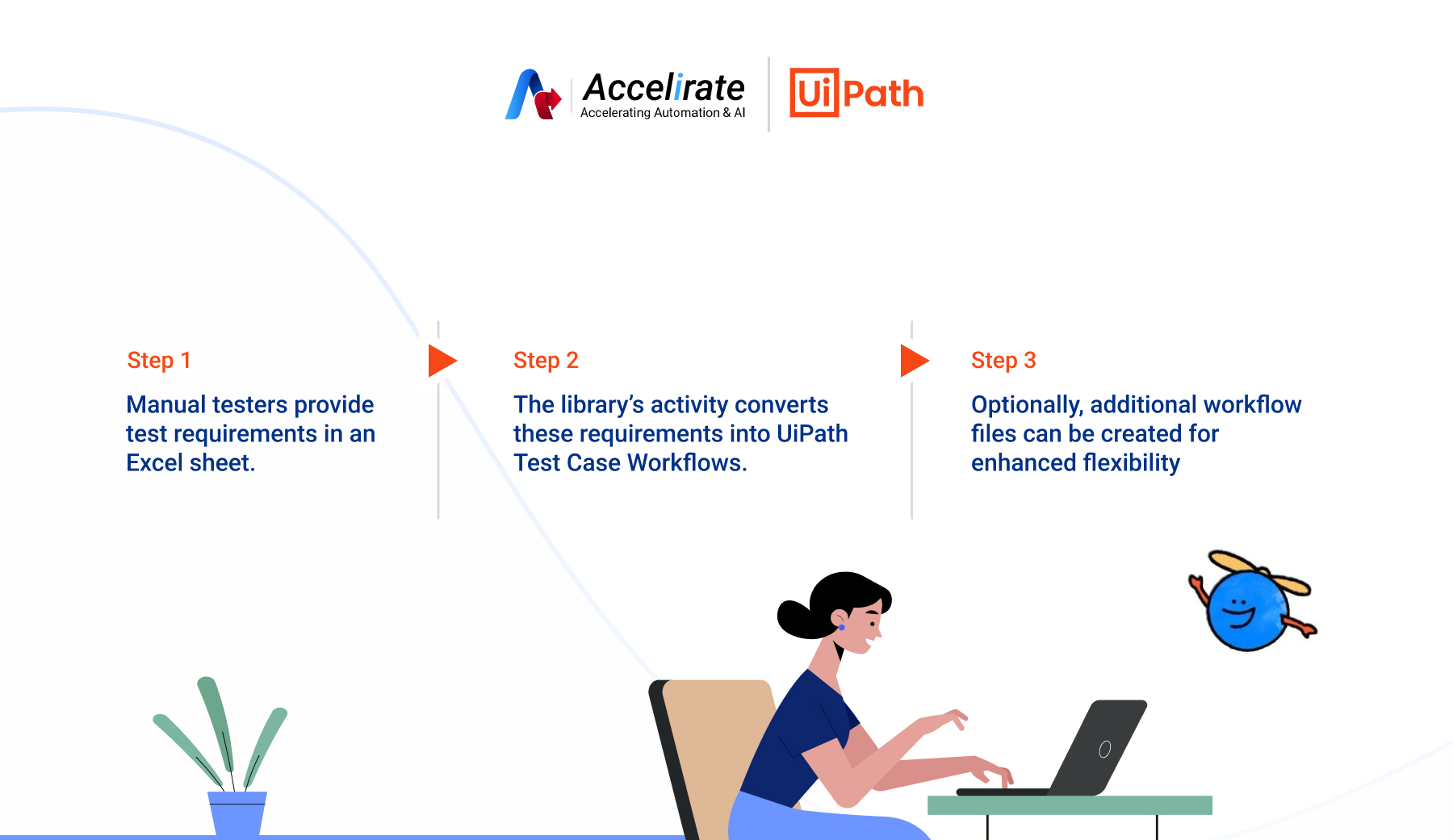UiPath Test Suite
BLOG
7 min read
How to Migrate Legacy Test Cases to Low Code Platforms Like UiPath with Cucumber Test Automation
When it comes to test automation, migrating legacy test cases to low-code platforms like UiPath can significantly boost efficiency and reliability. In this blog, we delve into a use-case of automating end-to-end tests in UiPath using Accelirate’s UI Automation Cucumber Framework. Along the way, we will also talk about the challenges, solutions, advantages of this migration process, and much more. Ready to see how this change can simplify your testing efforts? Let’s get started!
Have you ever faced challenges with migrating test cases in your automation projects?
Let’s Discuss!What is Accelirate’s UI Automation Cucumber?
Accelirate's UI Automation Cucumber framework is designed to streamline the process of creating and executing automated tests within UiPath environments. By providing a comprehensive template structure, detailed logging capabilities, and customizable parameters, the framework aims to enhance efficiency, accuracy, and maintainability in test automation efforts. Accelirate's UI Automation Cucumber framework empowers testers to comprehensively test every component of their applications effortlessly.
What sets the framework apart is its seamless integration of invokable workflows, enabling testers to cover a wide range of scenarios and functionalities easily.
Key Features of Accelirate’s UI Automation Cucumber
Cucumber is a popular tool for behaviour-driven development (BDD), which allows writing executable specifications in a plain text format. While Cucumber itself is not directly integrated with UiPath, it can be used in conjunction with UiPath for test automation.
- Generate Testcases Activity: It is the core component of this library that converts test requirements from an Excel sheet (provided by manual testers or testing teams) into UiPath Test Case Workflows seamlessly.
- Invokable Workflows: These are standard UiPath Workflows designed to empower users to create essential logic within their test cases. These workflows can be invoked within Automated Test Cases, offering a modular and reusable approach.
With these workflows and functionalities, the library ensures full control over test case logic and fosters flexibility across projects, whether they involve robotic process automation (RPA) or test automation.
How Does It Work?
Here is how our library streamlines the test automation process within UiPath environments.

Potential Migration Challenges
Migrating end-to-end tests to UiPath using Cucumber can come with potential challenges that need to be addressed for a successful transition. In this section, we will explore the key challenges faced during this migration process and discuss how to overcome them.
- Syntax and Framework Differences: Cucumber relies on Gherkin syntax for defining test scenarios, whereas UiPath utilizes a visual workflow designer to create automation workflows. Adapting existing test scenarios written in Gherkin to UiPath's workflow format requires careful consideration of syntax and framework differences.
- Integration with UiPath Ecosystem: Integrating end-to-end tests with UiPath involves leveraging UiPath Studio, Orchestrator, and other components of the UiPath ecosystem. Ensuring seamless integration and compatibility with existing infrastructure is essential for successful migration.
- Handling Test Data and Dependencies: Migrating end-to-end tests may involve dealing with complex test data sets and dependencies on external systems. Maintaining data integrity and handling dependencies effectively during the migration process is critical to preserving test coverage and accuracy.
How do you validate the correctness and performance of your migrated test cases?
Connect with Experts!Strategic Solutions for the Migration
Successfully migrating end-to-end tests to UiPath using Cucumber requires a strategic approach that addresses the various challenges involved. This section outlines a comprehensive migration strategy that organizations can adopt to ensure a smooth transition. Let’s look at these expert strategies.
- Assess Test Suitability: Evaluate existing end-to-end test suites written in Cucumber to determine their suitability for migration to UiPath. Identify critical test scenarios, dependencies, and compatibility factors that may impact the migration process.
- Refactor Test Scenarios: Refactor existing test scenarios written in Gherkin to align with UiPath's workflow format. Translate high-level feature files and step definitions into UiPath workflows, ensuring clarity, readability, and maintainability of the automation logic.
- Leverage UiPath Activities: Utilize UiPath's extensive library of activities and predefined components to streamline automation development. Leverage activities for user interface interactions, data manipulation, and integration with external systems to expedite the migration process.
- Implement Reusability and Modularity: Design automation workflows in UiPath with reusability and modularity in mind. Encapsulate common automation logic into reusable components and libraries to promote code maintainability and scalability.
- Integrate with Testing Frameworks: Integrate UiPath automation workflows with existing testing frameworks and CI/CD pipelines to enable seamless execution and reporting. Leverage tools like Jenkins, Azure DevOps, or GitLab for test orchestration and integration with version control systems.
- Conduct Testing and Validation: Validate migrated end-to-end tests in UiPath to ensure functional correctness, data accuracy, and performance consistency. Conduct thorough testing across different environments and scenarios to identify and address any issues or discrepancies.
Advantages of Migrating with Accelirate’s UI Automation Cucumber
This migration comes with numerous benefits that can significantly enhance the efficiency and effectiveness of your test automation efforts. By leveraging UiPath's capabilities, organizations can make their tests more readable, promote collaboration, and improve reusability. Here are some of its key advantages:

- Readable and Understandable Tests: Cucumber tests are written in plain text using the Gherkin syntax, which makes them easily readable and understandable even by non-technical stakeholders. This is beneficial when collaborating on automation projects, especially when involving business analysts or domain experts.
- Better Collaboration: Cucumber facilitates collaboration between technical and non-technical team members. Business analysts or subject matter experts can write feature files in Gherkin syntax, specifying the expected behaviour of the software, while automation engineers can implement the step definitions to automate these behaviours using UiPath.
- Reusability: Cucumber promotes the reusability of step definitions. Once step definitions are implemented for a particular feature or scenario, they can be reused across multiple test cases, reducing duplication of effort and making maintenance easier.
Elevate Your Test Automation Efficiency through Strategic Migration
This use case showcases the power of strategic migration and the seamless integration of test automation solutions within the UiPath ecosystem. Migrating end-to-end tests to low code platforms like UiPath using Cucumber is a smart move to keep your test automation in sync with evolving business needs and technologies. By adopting a systematic migration strategy and leveraging UiPath's capabilities in RPA and automation, you can make your Cucumber BDD test automation more effective and efficient, ultimately streamlining business processes, improving software quality, and accelerating time-to-market for software products and applications.
Ready to transform your testing with UiPath? Teaming up with a trusted UiPath partner, like Accelirate, can enable you to optimize and simplify your test automation processes with proven automation solutions. Contact us today!
Looking for effective automation solutions?
Talk to Our Experts!
Gayatri Kumari
Senior Automation Engineer

Pratik P. Maskar
Automation Engineer



